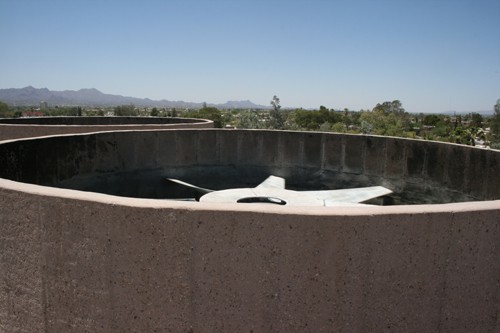Tucson residents are familiar with the battle to bear the burdens of summer living, in particular the costs of peak electrical hours during triple-digit summers, and the UA is no exception.
Likewise, no desert is without an oasis. A recent tour of the UA’s Central Refrigeration Plant, located on Helen Street and Mountain Avenue, highlighted the technology and methodology the university uses to balance out summer cooling costs.
Leading the tour were Central Plant mechanic lead Bruce Haldeman and plant administrator Joe Thomas. Within the control center of the plant, Haldeman and Thomas explained the basics of thermal storage. Peak summer hours are from noon to 8 p.m., Thomas said. To offset cooling costs, the plant freezes water at night to chill the school during the day.
The university thermal storage project includes three plants. Together, these plants loop 16 million gallons of chilled water across campus and the University Medical Center every hour, helping to cool 176 buildings across campus, Haldeman said.
Out back, a barrack of large silver cylinders glint in the sun whose light they were designed to counteract. The Central Refrigeration Plant makes ice in 165 of these thermal storage tanks, “”the second largest after the JC Penney home office,”” Thomas said. The tanks are filled with tubes of glycol, which is used to freeze the water in the tanks overnight. During peak electrical hours, water is cooled over this ice before being distributed across campus.
Thermal ice tanks aren’t the only key component of this energy-saving system. As the cool water from the plant absorbs heat from classrooms and offices, it makes its way back to the plant to be cooled and rerouted across campus. Above the tanks on the roof, 125-horsepower, 22-foot fans are used to disperse much of this heat “”like a giant swamp cooler,”” Thomas said.
The UA considered plans to build the plant as far back as 1996, though funding was not approved until 2004. Both Haldeman and Thomas pointed toward growing needs for innovative energy alternatives as a motivating factor for the plant’s approval.
“”It was like solar heating in the ‘70s,”” Haldeman said, noting the contribution of raising energy rates to interest in thermal storage. Likewise, Thomas cited the “”big brown-out in California and Enron”” as events that helped push more funding toward sustainable energy strategies.
The development of the thermal storage project was a joint effort between Sun Mechanical, APS Energy Services and the UA, Haldeman said.
Financially speaking, the plant saved enough to have paid back the cost of its construction in its first 25 months, said Thomas.
The thermal storage project is one of many sustainable practices used by the university to offset power costs. Nano-filtration techniques are used to eliminate a myriad of minerals from Tucson groundwater, allowing a greater volume of groundwater to be recycled for future campus cooling.
The campus is also home to two natural gas-powered gas turbines. The power generated from these 6.8 megawatt and 4.2 megawatt turbines offsets a large portion of the university’s daily electrical costs.
As temperatures and economic pressures rise, so do new efforts to combat these costs and help make the desert livable. At the forefront of this sustainable effort, it’s no surprise that the Central Refrigeration Plant is one of the chillest spots on campus.









